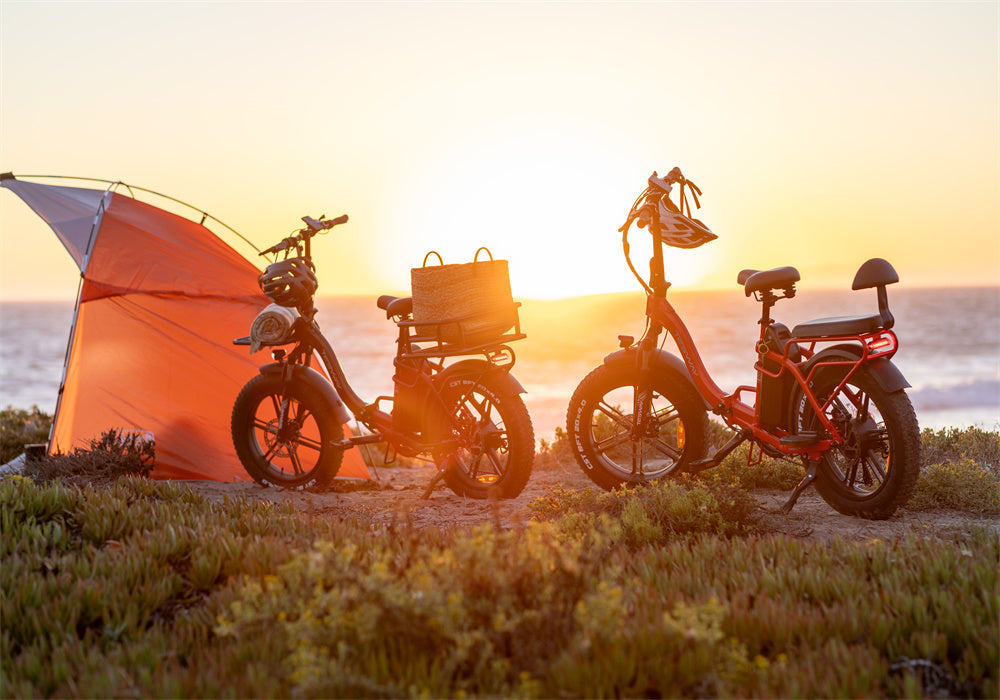Electric bikes have experienced a surge in popularity in recent years and have become a favored mode of transportation and recreation. According to market research reports, the e-bike market size was valued at over $15 billion in 2020 and is projected to reach over $24 billion by 2025, with a compound annual growth rate (CAGR) of 14.5%. The pedal-assist technology and eco-friendly e-bikes offer a convenient and efficient alternative to traditional bicycles and motor vehicles.

As e-bikes continue to gain traction among consumers, potential buyers must grasp the significance of e-bike weight in their purchasing decisions. The weight of an e-bike affects not only its performance but also its portability, handling, and overall riding experience.
The weight of e-bikes and average ebike weight refers to the total mass of an electric bike, including its frame, components, battery, motor, and any additional accessories. Taking these elements into account helps buyers navigate the diverse landscape of e-bike options and choose the right model for their needs.

Understanding the Weight of E-Bikes
An electric bike equipped with an electric motor that assists the rider’s propulsion. Electric bike components include the battery, motor, frame, and additional features like lights and displays that may vary depending on the model.
Factors that greatly contribute to the weight of electric bicycles include battery size, motor power, frame material, and added accompaniments. On average, e-bikes are heavier than traditional bicycles due to the expressed components, weighing anywhere from 20 to 70 pounds more, depending on the model and specifications.

The Impact of E-Bike Weight on Performance and Ride Quality
Upon analyzing the trends of e-bike weight over recent years, it’s evident that there has been a steady increase in the average weight of e-bikes. Much of the weight changes are directly connected to advancements in motor and battery technology, as well as the demand for more durable and versatile frames.
Many factors influence e-bike weight like the frame material used for construction. Some of the frame materials used include aluminum, carbon fiber, steel, and titanium. Each material varies in quality, features, durability, final appearance, and cost impacting the total weight of the bike.

The battery capacity is also another critical aspect of the weight of the electric bike. It is said that the batteries that house higher capacities grant longer rages but impact the weight greater.
The motor type and power also impact the total weight of the e-bike. There are two main motors for e-bikes: the hub motor and the mid-drive motor.
Hub motors are simple in design but tend to be heavier, while mid-drive motors present a bit better weight distribution and efficiency but overall still may add more weight to the bike. Additional features and components including the suspension, drivetrain, and electronics can increase weight.

What to Expect: Average Weight of an E-Bike
The weight of an E-bike has a lot to do with the model or type. There are many types of e-bikes, particularly the city, mountain, and cargo. The city’s average e-bike weight ranges from 45 to 60 pounds (20 to 27 kilograms). These models prioritize lightweight frames and parts for urban commuting and maneuverability.

The Mountain e-bikes are normally heavier due to the powerful frame construction and suspension systems necessary for off-road terrain which tend to be more rugged. The average mountain bike weight ranges from 50 to 65 pounds (23 to 29 kilograms).
The cargo e-bikes are specifically designed for transporting heavy loads and thus have the highest average weight among the e-bike family. They can easily weigh anywhere from 60 to over 100 pounds (27 to 45 or more kilograms), depending on the load capacity and build.

Then how do you know when an e-bike is considered heavy? The weight considered heavy for an e-bike will vary depending on the reason for use, frame material, and motor size. Generally, e-bikes weighing over 50 pounds (approximately 22.7 kilograms) are often considered heavy.
However, for certain types of e-bikes, such as cargo bikes or models with larger batteries and motors designed for off-road use, weights exceeding 60 or even 70 pounds (27 to 31.8 kilograms) can be considered the norm and not categorized as heavy. Ultimately, what constitutes a heavy e-bike differs based on individual preferences and intended riding conditions.

Reviewing E-Bikes: TESWAY X5 and TESWAY S7
TESWAY has made big strides in the industry of electric bikes and continues to set the standard. With a commitment to quality, sleek design, comfort, efficiency, and durability, you are never left disappointed. Here are two TESWAY e-bikes to keep in mind when deciding to make a purchase.
TESWAY X5: This beauty of an e-bike boasts of functionality. It offers reliability for city life with a powerful 750w motor. Be ready for a smooth and secure ride (with double spring suspension) even when going through tough terrains.
The top speed is 28mph, a max load of 350 lbs, 70Nm motor torque, and 5-level pedal assistance. The TESWAY x5 also sports a 1200Wh battery with 8 hours of charge time, and a 48v 25A battery affording 50-80 miles per charge.
The modern display screen has battery capacity, an odometer, pedal assist level, a speedometer, power measurement as you travel, and even a USB port for charging your mobile phone. You also have your very own tail and brake light.

TESWAY S7: What elegance? The design of this electric bike mimics that of a swan backed with much power. The modern explorer will love this one. With this e-bike, you can cruise through any terrain with ease. The top speed is 28mph, it has a max load of 350 lbs, 70Nm motor torque, and 5-level pedal assistance.
The TESWAY S7 has a 960Wh battery with 7 hours of charge time, and a 48v 20A battery affording 50-70 miles charge per charge. The modern display screen has battery capacity, an odometer, pedal assist level, a speedometer, power measurement as you travel, and even a USB port for charging your mobile phone. There is also the feature of a hydraulic fork to offer smoother suspension in front for better control.

E-Bike: Weight, Handling and Control
The weight is often overlooked when purchasing a bike. Unfortunately, not many people take the time to pay attention to the reality that the bike's weight affects mobility and control. Weight plays a significant role in several aspects of e-bike performance as it relates to agility, power, climbing ability, and comfort.
Lighter e-bikes tend to be more agile and easier to maneuver, especially in tight spaces or when making sharp turns. Heavier e-bikes on the other hand may feel more stable at higher speeds but harder to control in urban environments.

The weight of an e-bike affects the efficiency and range of the battery. Heavier e-bikes use up more power than lighter models, resulting in a shorter battery life and range. Lighter e-bikes tend to have better climbing ability and faster acceleration due to their lower weight. Heavier e-bikes struggle more on steep inclines and take longer to reach top speeds.

Heavier e-bikes often provide a more stable ride than lighter bikes because they absorb a lot of the bumps. However, heavier electric bikes are more of a challenge at low speeds and require more effort to control, resulting in rider discomfort over longer distances.

Final Thoughts
When selecting an e-bike, it's important to match the weight to intended usage. Whether it be city commuting, off-road adventures, or long-distance touring. As an e-bike buyer, you want to pay attention to other practical tips for purchase like balancing weight with range, cost, motor power, and comfort. It is also very helpful to test ride and evaluate an e-bike in person before you decide to purchase where possible.
FAQs
What factors contribute to the weight of an e-bike?
The weight of an e-bike depends on the frame material, battery size, motor type, and size, suspension systems/accessories, and tire size.
How heavy are e-bikes compared to traditional bicycles?
E-bikes weigh far more than traditional bicycles due to the battery and motor. On average, e-bikes can weigh from 20 to 70 pounds depending on the model, while the average weight of regular bicycles is about 18 pounds.
Does the weight of an e-bike affect its performance?
E-bike weight influences handling, maneuverability, power consumption, range, climbing ability, acceleration, comfort, and stability. Lighter e-bikes at times tend to have better agility but less stability, while heavier e-bikes may provide better stability but are way harder to maneuver.







Share:
The Best Hybrid Electric Bikes You Didn't Know About Yet
Comparing 250W vs. 500W Motors on E-Bikes – Which Packs More Punch?